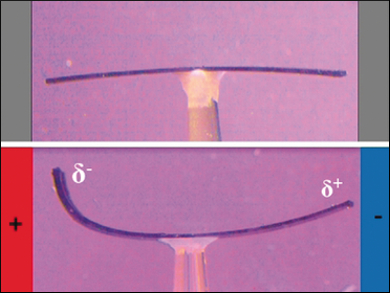The behavior of natural muscles can be imitated by conducting polymer actuators, i.e, materials that can move under certain circumstances. However, the electrochemically triggered movement in such devices is limited because they need a direct connection between the polymer and an electrical power supply. “Wireless” electrochemistry, in contrast, could stimulate actuation without physical contact.
Alexander Kuhn and colleagues, University of Bordeaux, Pessac, France, have used bipolar electrochemistry to stimulate large-amplitude actuation in a free-standing polymer immersed in an electrolyte. The team synthesized a bilayer polypyrrole film which has faces with differing density and anion-doping capacities.
Exposure of the conducting polymer to an electric field causes asymmetric ion-transfer processes and simultaneous oxidation and reduction reactions at the extremities of the film. This, in turn, causes differential shrinking and swelling. Local volume changes in the polymer allow controlled bending (pictured), and the direction of the physical response can be reversed by inverting the orientation of the electric field.
Dynamic materials that mimic the behavior of natural muscles could be applied in (micro)robotics or as active elements in valves, pumps, and microfluidic devices.
- Wireless Electrochemical Actuation of Conducting Polymers,
Bhavana Gupta, Bertrand Goudeau, Alexander Kuhn,
Angew. Chem. Int. Ed. 2017, 56, 14183–14186.
DOI: 10.1002/anie.201709038


![Synthesis of [c2]Daisy Chains via Mechanochemistry](https://www.chemistryviews.org/wp-content/uploads/2025/04/202504_RotaxanesWithSolidStateMechanochemistry-125x94.png)

